Vitamin B12 and Biotin: Partners in the Citric Acid Cycle
Vitamin B12 and biotin (i.e. vitamin B7, vitamin H) work together in the mitochondria. The mitochondria are the “power plants” of our cells: here a whole series of reactions take place, collectively known as the citric acid cycle (also: tricarboxylic acid or Krebs cycle), which produce energy for our body.
Biotin and B12 – in the B12 form of adenosylcobalamin – work as a coenzyme in two directly successive metabolic steps: the biotin-dependent reaction provides the starting substance for the B12-dependent reaction (1, 2).
Without a sufficient supply of biotin, adenosylcobalamin cannot take effect (3, 4).
Vitamin B12 – Made Ineffectual by Biotin Deficiency
As the diagram above shows, B12 cannot function when there is a biotin deficiency, since the starting substance required by B12 for its relevant reaction, methylmalonyl-CoA, is missing.
Biotin deficiency can thus lead to a functional B12 deficiency, even if sufficient adenosylcobalamin is present.
The other way around, a biotin deficiency can also arise due to a sudden, large influx of B12 – as in high-dose initial therapy. This is because, through correcting the B12 level, the metabolic steps that were previously blocked are suddenly increasingly carried out. As a result, correspondingly larger amounts of biotin are consumed. If the biotin level is already in the lower range before B12 therapy begins, the biotin supply can be impaired.
Nutrient experts such as Dr Bodo Kuklinski therefore recommend taking biotin as part of a vitamin B12 therapy:
“Vitamin B12 has no effect without an accompanying biotin intake […] Under vitamin B12 therapy, the need for biotin increases, and if not supplemented, skin problems, brittle hair and nails as well as spots occur. These are an indication of a biotin deficit […] With nitrosative stress we often found marginal or pathologically low biotin concentrations in the blood. Without biotin vitamin B12 does not work; the effects of B12 decrease without biotin substitution” (5).
Other therapists have also reported good results with this combination.
When Does Taking a Combination of Vitamin B12 and Biotin Make Sense?
A clinical biotin deficiency is very rare. However, our exact requirement for the vitamin is unknown and even in the absence of clear deficiency symptoms there may be an undersupply (6).
This is difficult to determine in the laboratory, because unfortunately there is no simple test for a biotin deficiency. Similar to magnesium, the blood values of biotin remain relatively constant even when cellular deficiency occurs (7). Although there are some secondary biomarkers such as the measurement of certain enzyme activities in the leukocytes or the excretion of 3-hydroxy-3-methylbutyric acid in the urine, these are ambiguous indications and only a few doctors are familiar with the corresponding tests (8, 9).
As cited above, nutrient therapists such as Dr Kuklinski recommend a general administration of biotin as part of a high-dose B12 therapy. The consumption of biotin increases during the therapy in any case, so that an additional supply is generally helpful.
The rationale for such a recommendation is also that biotin – like B12 – has no toxic effect whatsoever. Neither side effects nor overdoses of biotin are known. Although biotin competes with vitamin B5 for the same absorption mechanism, this is irrelevant if biotin is taken in moderate amounts. Even at extremely high doses of 5 mg, this interaction can easily be circumvented by taking biotin separately – independent of meals or a vitamin B complex.
How Much Biotin for Vitamin B12 Treatment?
How high should biotin be dosed as part of vitamin B12 treatment? Various recommendations exist and the exact need for biotin is not yet known (10).
The biotin requirement is covered through two sources:
- Production by gut bacteria
Part of the requirement is met through biotin production in the gut by certain bacteria – however, this is not always guaranteed, for instance following a course of antibiotics. - Dietary intake
A further part of the intake is obtained through the diet.
So far it is unknown how large the respective contribution of intestinal bacteria and food is to the total requirement of the biotin supply. The following recommendations and estimates can serve as reference points:
Source | Recommendation for | Dose/Day (µg) |
Estimate | Total requirement | 150 – 300 |
IOM | Adequate intake | 30 |
EFSA recommendation | Dietary supply | 40 |
Gröber [11] | General prevention | 100 – 300 |
Gröber | Treatment deficiency | 2500 |
Kuklinski | To accompany high-dose B12 therapy | 2500 – 5000 |
Since biotin is 100% absorbed, the recommendations for the general prevention of Uwe Gröber seem sufficient (12). If there are clear symptoms of biotin deficiency, the recommendations for the treatment of a deficiency are advisable.
Foods Containing Biotin
The following foods contain large amounts of biotin. The data refer to 100 g.
| Food | Biotin per 100g in µg |
| Yeast | 200 |
| Beef liver (cooked) | 100 |
| Peanut butter | 67 |
| Egg yolk | 50 |
| Hazelnuts | 39 |
| Oats | 20 |
| Walnuts | 19 |
| Mushrooms | 12 |
| Brown rice | 12 |
| Sesame | 11 |
| Avocado | 10 |
| Almonds, sunflower seeds, linseed | 10 |
| Whole wheat flour | 8 |
| Peas | 8 |
| Fish | 7 |
| Spinach | 6 |
| Beef and pork | 5 |
| Bananas | 5 |
Biotin Deficiency – Cause of Vitamin B12 Acne?
As mentioned above, some researchers suspect that the biotin deficiency that occurs during B12 therapy might be the cause of B12 acne: some people who take B12 experience severe acne, the cause of which has remained a mystery for years.
Kuklinski and other therapists report that this acne can be prevented by the additional administration of biotin.
This makes theoretical sense due to the known effect of biotin on the skin, although the exact mechanism of action is still unknown. Additionally, it is known that high-dose biotin can help with acne, but can also trigger acne itself, as it hinders the absorption of vitamin B5 in the intestine.
However, due to the positive experiences of hundreds of patients, taking B12 and biotin together is definitely worth a try if vitamin B12 alone leads to acne outbreaks.
Further reading: Vitamin B12 and Acne
Conclusion: Vitamin B12 and Biotin
Vitamin B12 depends on an adequate supply of biotin; part of B12’s effect can only take place if the supply of biotin is ensured.
In conclusion, during high-dose initial therapy following deficiency and if the biotin supply is in doubt, it is advisable to take additional biotin.
Sources
- Stadtman ER, Overath P, Eggerer H, Lynen F (1960) The role of biotin and vitamin B12 coenzyme in propionate metabolism. Biochem Biophys Res Commun 2:1–7 DOI: 10.1016/0006-291X (60)90252-7
- Wood HG, Kellermeyer RW, Stjernholm R, Allen SH (1964) Metabolism of Methylmalonyl-coa and the Role of Biotin and B12 Coenzymes. Ann N Y Acad Sci 112:660–679 PMID: 14167300
- Elin RJ, Winter WE (2001) Methylmalonic acid: a test whose time has come? Arch Pathol Lab Med 125:824–827 PMID: 11371242
- Smith RM, Monty KJ (1959) Vitamin B12 and propionate metabolism. Biochem Biophys Res Commun 1:105–109 DOI: 10.1016/0006-291X (59)90073-7
- Kuklinski B, Lunteren I van (2013) Gesünder mit Mikronährstoffen: schützen Sie Ihre Zellen vor “Freien Radikalen,” Erw. Neuaufl., 3. Aufl. Aurum, Bielefeld
- Said HM (1999) Biotin bioavailability and estimated average requirement: why bother? Am J Clin Nutr 69:352–353 PMID: 10075316
- Lord RS, Bralley JA (2008) Laboratory evaluations for integrative and functional medicine. Metametrix Institute, Duluth
- Zempleni J (ed) (2007) Handbook of vitamins, 4th ed. Taylor & Francis, Boca Raton
- Eng WK, Giraud D, Schlegel VL, Wang D, Lee BH, Zempleni J (2013) Identification and assessment of markers of biotin status in healthy adults. Br J Nutr 110:321–329 PMCID: PMC4743878
- Mock DM (1999) Biotin status: which are valid indicators and how do we know? J Nutr 129:498S–503S PMID: 10064317
- Gröber U (2011) Mikronährstoffe: Metabolic Tuning, Prävention, Therapie, 3., völlig überarb. und erw. Aufl. WVG, Wiss. Verl.-Ges, Stuttgart
- Zempleni J, Mock DM (1999) Bioavailability of biotin given orally to humans in pharmacologic doses. Am J Clin Nutr 69:504–508 PMID: 10075337
Photo: Nuts by Mariya Chorna. Licence: cc-by-sa



